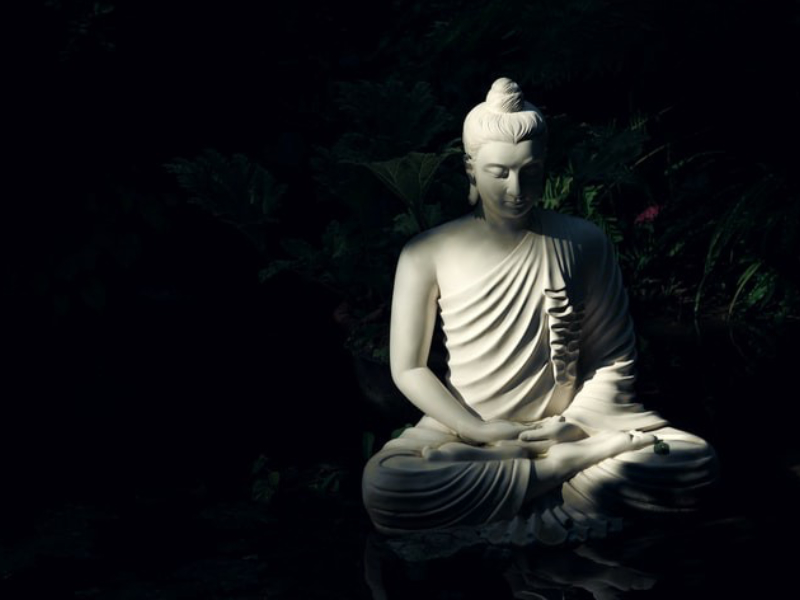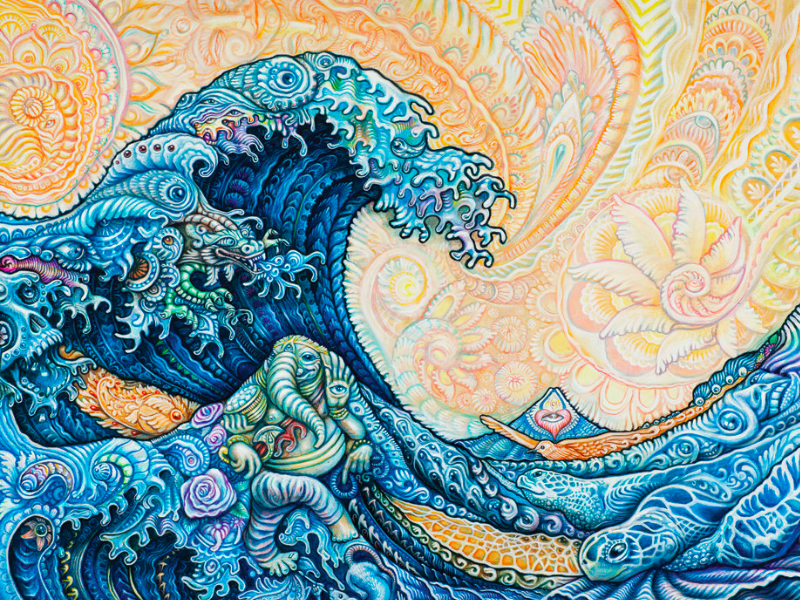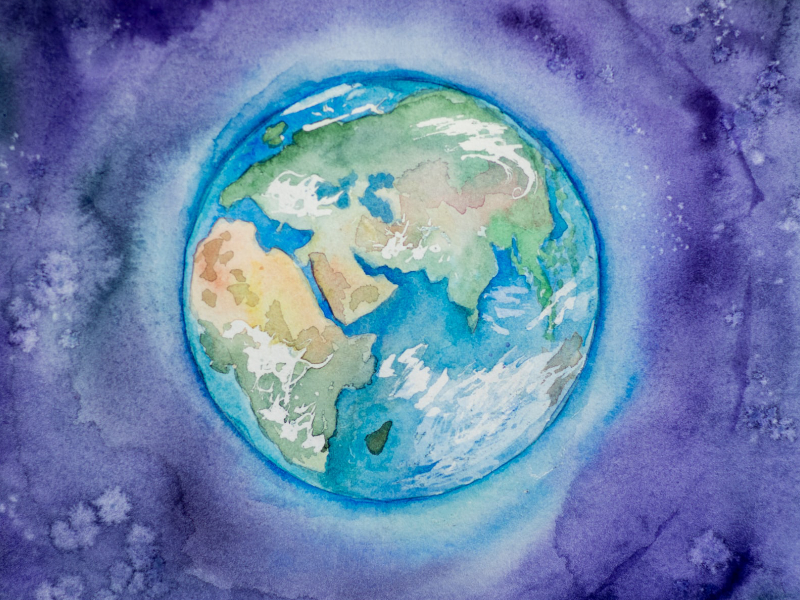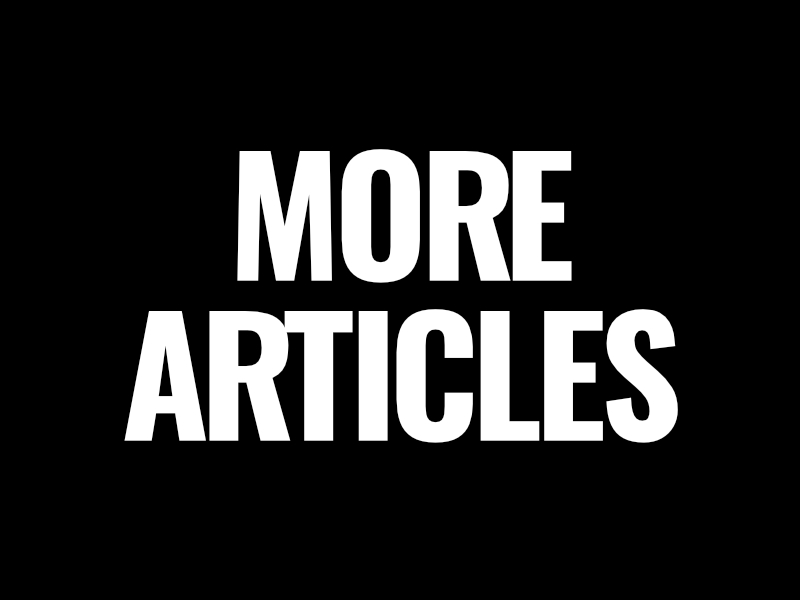Building a Lens of Freedom
– The role of perception in the pursuit of freedom –
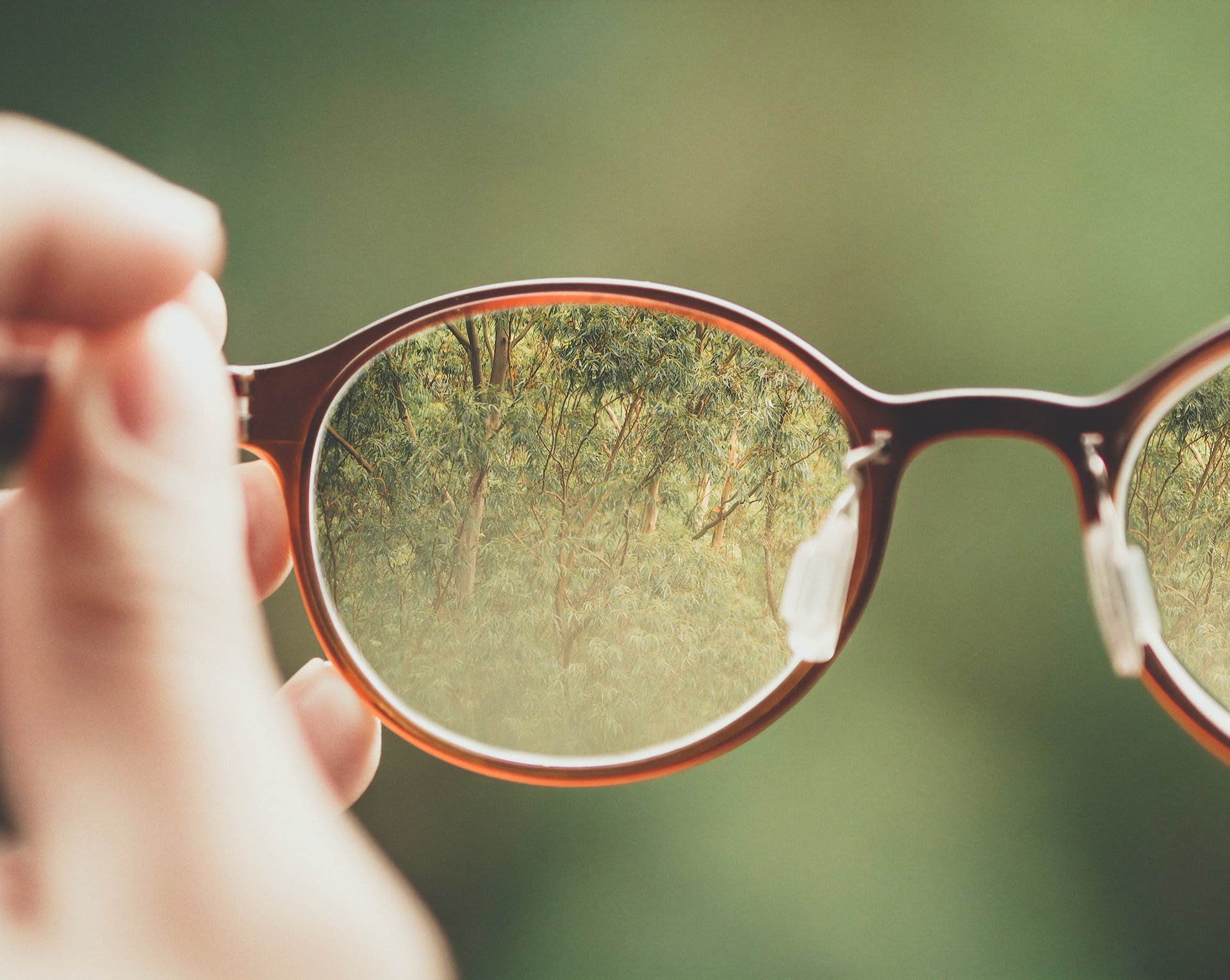
Today I want to pick up where we left off, continuing our exploration of the Noble Eightfold Path. So, just to recap, in my last article, A Way To Transform Your Suffering, I expressed that the Eightfold Path provides us with a means or a foundation and framework to support us in our pursuit of peace and freedom. And it does this by encouraging us to listen to and live in harmony with the Dharma — with Truth, Reality, Law, Nature, Life, God, etc.
More specifically, I spoke about one of these eight folds, our worldview and understanding, which I mentioned takes shape naturally as a part of the human experience, because it is this worldview that acts as our operating system, it is this worldview that navigates us through the terrains of existence, that moves our lips and our limbs. It is through this worldview that we come to know ourselves, the world, and our place in it. It is our worldview that shapes our entire lives, that shapes our entire experience.
Today, then, because this first fold is so important in our pursuit of peace and freedom, we’re going to continue exploring it in a bit more depth. And we’ll do so through the window of perception, which together with thought constructs our entire understanding and model of the world, or experience.
But before we move into the role of perception in the Eightfold Path, let me first clarify the word ‘Path’ a bit, since it can be somewhat misleading. ‘Path’ makes the Eightfold Path sound linear, which it isn’t. On this Path, there is actually no starting place. Rather, each ‘step’ or ‘fold’ on the Eightfold Path works in conjunction with all the others to support us on our journey of peace.
So, it might actually be more useful to think of the Eightfold Path as a wheel that carries us smoothly through the terrain of life and experience, with each of the eight steps considered as spokes on that wheel.
* * *
Okay, with that said, let’s now take a look at the faculty of perception.
The Faculty of Perception
To begin, let us consider how one comes to hold a worldview? How does a baby come out of the womb without any ideas of itself or the world, without any prejudices or biases, without any opinions or beliefs, and one day come to hold a complex model of themselves, the world around them, and their relations and preferences to it? How do we come to know and relate to the world of things?
* * *
What is the Faculty of Perception?
When I was a kid, I used to lay on the bed with my siblings and look up at the plaster patterns on the ceiling. We would see all kinds of shapes in the patterns — animals, faces, landscapes, objects, monsters, and all kinds of things. I’m sure you’ve done something like this, like laying on the grass and looking up at the clouds or stars, which told you endless stories.
This is our perception at work. The faculty of perception takes sensory data — in this case, light waves that have bounced off the clouds and ended up in our eyes — and then constructs them into a distinct concept, organizing the data into like-patterns, creating a useful model or experience we can make sense of.
Without perception, we wouldn’t be able to distinguish the world of things. Our experience would be a seamless, ever-changing mess of noise — lights, shadows, colors, smells, sounds, etc., with no way to distinguish anything from anything else.
In our example, then, instead of just seeing a seamless and ever-changing soup of light waves — colors, shadows, and light — the faculty of perception allows us to perceive white clouds as distinct and separate from the blue sky, both of which are in relation not only to each other but also to our self, an additional concept.
The neurologist and physician Oliver Sacks tells a story of a patient whose vision he was able to restore, which really captures the point I’m trying to make here. After the procedure whereby Dr. Sacks restored the patient’s vision, Sacks asked the patient, “Well…what do you see?” The patient paused. It turns out that the patient’s visual field was restored but all he could see was a chaotic mess of moving lights, colors, and shadows. And it wasn’t until the patient could tie the movement of Sack’s lips to the patient’s perception of Sack’s voice that the picture started coming into view.
Now, what’s interesting to take away from this story is that we most often take our perception of the world for granted. We think this is the way the world is — exactly how we experience it. Rather than seeing all this data as continuous waves of light, sound, etc., we experience a world of things. We see cars, homes, people, plants, clouds, and more.
And this isn’t only true for what we see. It’s also true for all our sensory experiences. We hear phones ring, for example. We hear people speak and dogs bark. We feel our hands rest against our legs. But without our perception, each of these ‘things’ would melt into a chaotic, ever-changing wave of noise, inseparable from one another and inseparable from the rest of experience.
To be clear, I’m not talking about thoughts here. When we gaze out into a room, for example, we are not having thoughts about each thing in the room. But our perception is still unconsciously registering everything. We don’t panic because our entire visual field is organized nicely, even though we aren’t having active thoughts about each thing in our field of vision. Thoughts, of course, are important in constructing a worldview, but we’ll get to thoughts another time. Today, I just want to focus on perception.
So, just to recap, the faculty of perception collects sensory data, organizes it into a useful category or concept, which it then stores in memory to pull from later, when it detects like-patterns. In other words, perception creates our moment-to-moment world of appearances. It takes a chaotic world of ever-changing sensory data and molds it into a coherent and stable model of the world, or experience. It even molds the perception of a continuous and stable experience of ‘self’.
Now, an important question to ask for those of us practicing the Dharma, is whether our perception is aligned with reality? Can we reliably say that our perception is providing us an accurate view of the world and of ourselves?
My partner has an excellent story to highlight my point here. When she and her ex-husband were on their honeymoon in Europe, they stayed in a hotel that smelled terribly rotten. It bothered both of them immensely. After a couple days, though, when they were walking near their hotel, they saw a fromagerie, or cheese factory, connected to their hotel. From this point on, the smell no longer bothered them but in fact delighted them.
Another thing to consider here is the perception of other animals. Snakes, for example, experience the world of vision in infrared. Bats experience a visual representation of the world through sound waves, and dogs see with their olfactory system. Do we have the correct view of the world, or do one of these other animals have the correct view?
And wait…are there actual stable, clearly defined things in reality?
* * *
Building Our Lens of Perception
Let’s get back to our newborn baby. Just consider that this baby comes into the world and has no ideas about anything. It doesn’t have a concept of self or other. It doesn’t have a concept of life or death, of up or down, left or right, good or bad. It must build its perception of each of these in time (time being another concept it must build). Until then, it’s like Dr. Sack’s patient — there exists only an undifferentiated field of ever-changing waves.
So, how do we accomplish this incredible feat of building a perception? Well, we don’t do it at all. I didn’t build my perception, nor did you. Our perception of the world arises through numerous causes and conditions — the families, environments, and communities we’re born into; the language, traditions, institutions, norms, and belief systems of our respective cultures; the trends, styles, and preferences of our generation; the books we read and movies we watch; the friend groups we hang out with; our prior experiences; our interests and impulses; our genetic makeup (snake vs human, and even genetic differences among humans, like those who experience sensory disorders); and on and on.
What makes perception so complex is that we don’t all perceive things the same way. In fact, none of us perceive anything the same way. We each build our own model. And none of us, not even twins, have the exact same circumstances and experiences. Our unique conditions cause us to perceive the exact same thing (person or situation) differently. One person, for example, may perceive a dog jumping on them as a threat, while another person may perceive an excited and loving dog happy to see them.
Perception, then, is a conjectural and creative process. More accurately, it’s both a conjectural and a critical process, a continuous feedback loop of trial and the elimination of error, just like the scientific method, natural selection, and every other knowledge creating process.
Just as in science, where we put forward a hypothesis and then rigorously test and adjust this hypothesis against observation, experimentation, and critical reasoning, our faculty of perception creates a collection of useful concepts, which it continuously refines and adjusts as it gets feedback through additional sensory data. But, we can never say, with science or perception, that we’ve come to the Final True perception or theory of anything.
“Experience is the name everyone gives to their mistakes.” — Oscar Wilde
[If you’re interested in deepening your understanding of this process, check out this article. It will speak a bit about how our innate impulses, like hunger, present problems when they are confronted by obstacles in our environment, which require us to create concepts (ideas) to overcome the obstacles.]
Perception of the Relative & Ultimate | Wearing Bifocals
At this point, it may be useful to recall the Buddha’s two worldviews or sets of lenses he wore like bifocals — the relative view and the ultimate view. When he looked through the ultimate view, the Buddha saw that there was in fact no thing. The world is an ever-changing, seamless whole. But when he looked through the relative lens, he noticed that his perception of the world was not seamless. It was fractured and divided into many pieces, each of which stood in relation to one another, including himself.
And again, it’s important here to continually bring into the forefront our motivation and intention, so we don’t get stuck intellectualizing everything or getting lost in the abstract realm, disconnected from this human life. Remember, our pursuit here is peace and freedom. And our approach to this peace and freedom is to live in accordance with the Dharma, with Truth, Reality, Nature, Life, etc.
So, considering both the relative and ultimate view, along with our aim, how can we take this understanding of perception and apply it to live a better life, to remain on the path of peace and freedom?
Well, with our relative lens, we can open our perception to include several relational laws, including the nature of cause & effect. Though the relative world is entirely conjectural and conditional, each person with their own experiential lens, there are still laws, relational laws that are born out of the undivided whole. So, it’s still important that we build a wise perception of it.
Just consider a jigsaw puzzle, a picture sliced up into pieces. Each piece doesn’t fit with all the rest. No, there’s still structure and order there. We need to see how each piece relates to the others and fits into the whole. The same is true with math and the law of the conservation of energy. If you think 2+2=5, for example, life’s gonna be tough to navigate. The world is one of give and take. Nothing comes free. Every action has a reaction. What we do over here affects what happens over there.
But more specifically, for those of us interested in peace and freedom, in building our relative lens, I invite you to start examining directly in your own lives the internal and external consequences of your motivations. The more you can witness directly that each of your words and actions have consequences, and that each of these words and actions are preceded by an intention and motivation, the more you can align yourself with the way the world is. See if this allignment brings more peace and harmony into your life and being.
When we speak or act, are your intentions motivated by good-will — by generosity, kindness, or wisdom? What is the internal consequences of acting or speaking out of goodwill? What about when your words and actions are rooted in ill-will — in greed, hatred, or delusion? What happens to your being? Remember, you are inextricably linked to all the rest, not separate, cut off, and isolated from the world.
By witnessing directly these consequences again and again, you can build this understanding into your perception. A chess player who knows the moves of all the chess pieces isn’t surprised by the consequences of moving her piece to a vulnerable and undefended square. The consequences are perceived without effort. The same is true for those who have spent enough time examining directly the consequences of their motivations. More and more you will act naturally out of generosity, kindness, and wisdom, bringing more and more peace and harmony into your life and being.
* * *
Again, the relative world is the world that holds each of us and our stories in relation to one another. It’s where we play out the dramas of our lives. We need to live in a context, in a story. We just need to make sure we carry in our perception the whole, and to hold the intention to continually adjust our stories, through trial and the elimination of error, so we can live more and more in harmony with the Truth.
And, most importantly, we need to keep front and center in these stories our motivations and intentions. Let these become some of the main characters in your story plots. Keep an eye on them and see what they lead to, internally and externally.
I can guarantee you that this will continue to raise your wellbeing. It will continue to strengthen and deepen your relationships, making them more meaningful. It will uplift your art and your work. It will uplift your entire life.
If you want to embody nirvana, though, or the highest peace, we need to go further. We need to be able to look through the ultimate lens, which will require more. It will require a sustained mindfulness.
Wise Perception | The Role of Concentration & Mindfulness
Without concentration, we wouldn’t be able to stick to anything — a plan, a thought, an idea, or a story. Concentration is a foundational skill for life, necessary for anything and everything you could possibly pursue. You can’t get anywhere without it.
It is concentration and perception, then, working together, that keep us grounded to a story, to a framework, to a model, to whatever life-game is happening. It is concentration and perception that allow us to build a relative lens and to operate out of this lens.
But in order to develop insight and wisdom, which lead us to lasting peace and freedom, we also need to cultivate mindfulness. Mindfulness moves beyond concepts, moves beyond our simple recognition of the world of things, moves beyond our stories. Mindfulness penetrates and uncovers the very nature of mind or experience itself. It witnesses directly the ever-changing, insubstantial, selfless, interconnected nature of all things.
To provide some more clarity here, consider that even when we are lost in thought, we still recognize what it is we’re thinking in the moment. But this doesn’t bring us lasting peace. Our thoughts are wild, and can send us to heaven and hell and back again in just a few moments. So, we also need the addition of mindfulness to know that we’re thinking.
We need mindfulness to to witness the passing show of thoughts, to witness them as the cloud of changing energy that they are. Perception itself does not lead to the insight of the ever-changing, selfless, and inter-connected nature of all things, because it produces and engages in the content, in the story, in the appearances of reality.
Mindfulness, on the other hand, emerges from the story and notices the passing show, the continuous arising and fading of all things — sense impressions, perceptions, thoughts, emotions, etc.
Just consider the last time you watched a movie. When you watch a movie, the idea is to get sucked into the story, right? You empathize and relate to the various characters and their situations. You hold judgments and opinions about everything. You are truly in the story.
Usually, you’re so in the story that you don’t even realize that the movie is actually just a collection of pixels of light on a screen, continually arising and passing away. It’s just a passing show of light, a chain of 1s and 0s being processed by a computer and transferred to a screen and some speakers.
Imagine now, though, that in the movie, one of the characters pointed out the fact that movies are in fact just a passing show of pixels of light on a screen. You would then become directly aware of this fact. Mindfulness is like this. It emerges from the story. It itself is a part of the story, a part of the story which tells us to look deeper.
The key to building the ultimate lens, then, is to cultivate mindfulness, a continuous mindfulness, which will also require strong concentration. Balancing concentration, perception, and mindfulness is key to a sustained peace and freedom. Let mindfulness become the habit of your mind.
The famous Zen master Suzuki Roshi, when asked by one of his students to condense Buddhism into one phrase, replied, “Everything changes.” When you understand this, when you really understand this, not just conceptually but as a matter of direct experience, then you will have found the key to lasting peace and freedom.
In a world of constant change, when we try to hold onto things — anything; a person, a relationship, an identity, a belief, or even a view or perception— as permanent, then we are bound to suffer. All things that are of the nature to arise, which is all things, are also of the nature to pass away.
“If you let go a little, you will have a little peace.
If you let go a lot, you will have a lot of peace.
If you let go completely, you will have complete peace.”
-Ajahn Chah
John Driggs | Meditation Teacher & Founder of The Space of Possibility Podcast, Blog, & Retreat Center | Explore & Expand the Space of Possibility that You are!
More Articles
“The Art of Bare Attention”
Today we’re going to talk about the ancient Buddhist practice vipassana, or insight meditation. Now, just to be clear, this is an entirely secular practice. It doesn’t require you to adopt any dogmatic beliefs…
“The Faceless Seer”
How do you hold your love? Do you hold her from stillness, with nowhere to go, with nothing to do? How do you hold your love? Do you hold her with acceptance, with open hands and arms, with unabashed…
“Everything Changes”
It’s no secret everything changes. Your experience this morning isn’t your experience now. Yet how many of us act like we really understand this? How often do we grasp onto the illusion of things…
“The Divine Connection”
How do you hold your love? Do you hold her from stillness, with nowhere to go, with nothing to do? How do you hold your love? Do you hold her with acceptance, with open hands and arms, with unabashed…

